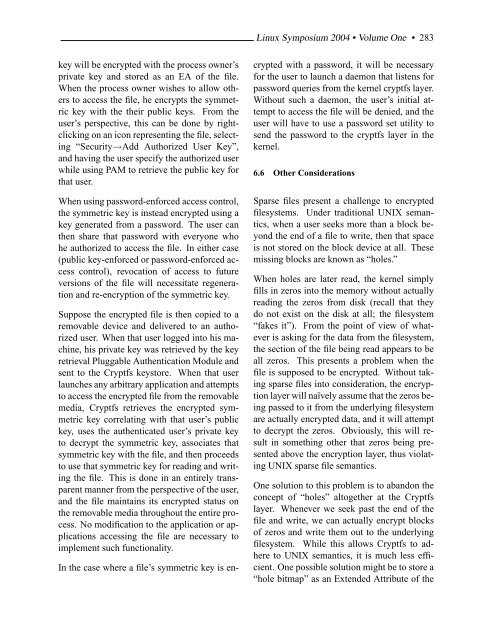Create successful ePaper yourself
Turn your PDF publications into a flip-book with our unique Google optimized e-Paper software.
<strong>Linux</strong> Symposium 2004 • Volume <strong>One</strong> • 283<br />
key will be encrypted with the process owner’s<br />
private key and stored as an EA of the file.<br />
When the process owner wishes to allow others<br />
to access the file, he encrypts the symmetric<br />
key with the their public keys. From the<br />
user’s perspective, this can be done by rightclicking<br />
on an icon representing the file, selecting<br />
“Security→Add Authorized User Key”,<br />
and having the user specify the authorized user<br />
while using PAM to retrieve the public key for<br />
that user.<br />
When using password-enforced access control,<br />
the symmetric key is instead encrypted using a<br />
key generated from a password. <strong>The</strong> user can<br />
then share that password with everyone who<br />
he authorized to access the file. In either case<br />
(public key-enforced or password-enforced access<br />
control), revocation of access to future<br />
versions of the file will necessitate regeneration<br />
and re-encryption of the symmetric key.<br />
Suppose the encrypted file is then copied to a<br />
removable device and delivered to an authorized<br />
user. When that user logged into his machine,<br />
his private key was retrieved by the key<br />
retrieval Pluggable Authentication Module and<br />
sent to the Cryptfs keystore. When that user<br />
launches any arbitrary application and attempts<br />
to access the encrypted file from the removable<br />
media, Cryptfs retrieves the encrypted symmetric<br />
key correlating with that user’s public<br />
key, uses the authenticated user’s private key<br />
to decrypt the symmetric key, associates that<br />
symmetric key with the file, and then proceeds<br />
to use that symmetric key for reading and writing<br />
the file. This is done in an entirely transparent<br />
manner from the perspective of the user,<br />
and the file maintains its encrypted status on<br />
the removable media throughout the entire process.<br />
No modification to the application or applications<br />
accessing the file are necessary to<br />
implement such functionality.<br />
In the case where a file’s symmetric key is encrypted<br />
with a password, it will be necessary<br />
for the user to launch a daemon that listens for<br />
password queries from the kernel cryptfs layer.<br />
Without such a daemon, the user’s initial attempt<br />
to access the file will be denied, and the<br />
user will have to use a password set utility to<br />
send the password to the cryptfs layer in the<br />
kernel.<br />
6.6 Other Considerations<br />
Sparse files present a challenge to encrypted<br />
filesystems. Under traditional UNIX semantics,<br />
when a user seeks more than a block beyond<br />
the end of a file to write, then that space<br />
is not stored on the block device at all. <strong>The</strong>se<br />
missing blocks are known as “holes.”<br />
When holes are later read, the kernel simply<br />
fills in zeros into the memory without actually<br />
reading the zeros from disk (recall that they<br />
do not exist on the disk at all; the filesystem<br />
“fakes it”). From the point of view of whatever<br />
is asking for the data from the filesystem,<br />
the section of the file being read appears to be<br />
all zeros. This presents a problem when the<br />
file is supposed to be encrypted. Without taking<br />
sparse files into consideration, the encryption<br />
layer will naïvely assume that the zeros being<br />
passed to it from the underlying filesystem<br />
are actually encrypted data, and it will attempt<br />
to decrypt the zeros. Obviously, this will result<br />
in something other that zeros being presented<br />
above the encryption layer, thus violating<br />
UNIX sparse file semantics.<br />
<strong>One</strong> solution to this problem is to abandon the<br />
concept of “holes” altogether at the Cryptfs<br />
layer. Whenever we seek past the end of the<br />
file and write, we can actually encrypt blocks<br />
of zeros and write them out to the underlying<br />
filesystem. While this allows Cryptfs to adhere<br />
to UNIX semantics, it is much less efficient.<br />
<strong>One</strong> possible solution might be to store a<br />
“hole bitmap” as an Extended Attribute of the

















